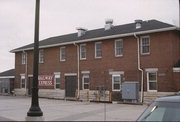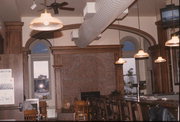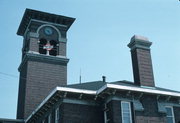Property Record
202 DOUSMAN ST
Architecture and History Inventory
| Historic Name: | Chicago & North Western Railway Passenger Depot |
|---|---|
| Other Name: | Titletown Brewing Company |
| Contributing: | |
| Reference Number: | 2030 |
| Location (Address): | 202 DOUSMAN ST |
|---|---|
| County: | Brown |
| City: | Green Bay |
| Township/Village: | |
| Unincorporated Community: | |
| Town: | |
| Range: | |
| Direction: | |
| Section: | |
| Quarter Section: | |
| Quarter/Quarter Section: |
| Year Built: | 1898 |
|---|---|
| Additions: | |
| Survey Date: | 19852021 |
| Historic Use: | depot |
| Architectural Style: | Neoclassical/Beaux Arts |
| Structural System: | |
| Wall Material: | Brick |
| Architect: | Frost and Granger |
| Other Buildings On Site: | |
| Demolished?: | No |
| Demolished Date: |
| National/State Register Listing Name: | Chicago and North Western Railway Passenger Depot |
|---|---|
| National Register Listing Date: | 12/30/1999 |
| State Register Listing Date: | 4/29/1999 |
| National Register Multiple Property Name: |
| Additional Information: | A 'site file' exists for this property. It contains additional information such as correspondence, newspaper clippings, or historical information. It is a public record and may be viewed in person at the State Historical Society, Division of Historic Preservation. Photo code #2: 75BR-8/17,19,20. When the Chicago and North Western Railway reached Green Bay in 1862, linking the area to Milwaukee, Racine, and Chicago, it touched off a lumber boom. Lumbermen no longer had to wait for spring thaws to float logs downriver, nor did they have to risk lumber and lives in thundering Fox River logjams or in savage storms sweeping Green Bay and Lake Michigan. Wisconsin became the nation’s fourth leading lumber state in the late nineteenth century, and Green Bay by 1870 ranked as the world's top producer of wooden shingles. Excessive lumbering exhausted the Northwoods white pines by the turn of the century, but the railroad never gave up on Green Bay. It built this Renaissance Revival depot in 1898, a decision that proved prescient when Green Bay re-emerged soon after as a leading manufacturer of pulpwood products, especially tissue paper. Intact brick-walled railroad depot with first floor used as passenger/freight depot, second floor used for offices. The building is divided into two separate two-story, hip roof pavillions placed at the north and south ends of the building which are connected by a short, one-story gable roof wing. The east facadeof the whole is dominated visually by a hip roof passenger veranda extending the length of the building and supported by square columns with three braces between the column and roof. The south or passenger depot pavillion has a tall hip roof with wide, overhanging eaves with a heavily bracketed cornice. A concrete beltcourse surrounds the block and forms the window sill for the second floor flat arch windows, while the first floor windows rest on the tall, rock-faced, rusticated cut stone foundation. The first floor windows are square-arch, 1/1 light within semi-circular arch transoms above and are set into the wall facade in such a manner as to suggest an arcade pattern. Dominating the main block is a five story tall clock tower with arcades on all four sides below a low hip roof having wide overhanging eaves with a massively bracketed cornice. ARCHITECTURAL/ENGINEERING SIGNIFICANCE The Chicago and Northwestern passenger depot is significant architecturally as an intact, original example of a small city railroad depot still in use for the company that built it. The depot is also a fine example of the Italian Renaissance Revival Style. The railroad station has been a visual landmark since it was built with its five story clock tower serving as a visual focus for several generations of Green Bay citizens. |
|---|---|
| Bibliographic References: | A. Green Bay Press-Gazette, July 1954, clipping in Brown County Library Local History files. B. Northwestern Lines, Winter 1982, pg. 17. Green Bay Press Gazette 12/11/1996. Take a Walk on Main Street: Historic Walking Tours in Wisconsin's Main Street Communities, Wisconsin Main Street Program, 1998. Buildings of Wisconsin manuscript. |
| Wisconsin Architecture and History Inventory, State Historic Preservation Office, Wisconsin Historical Society, Madison, Wisconsin |





